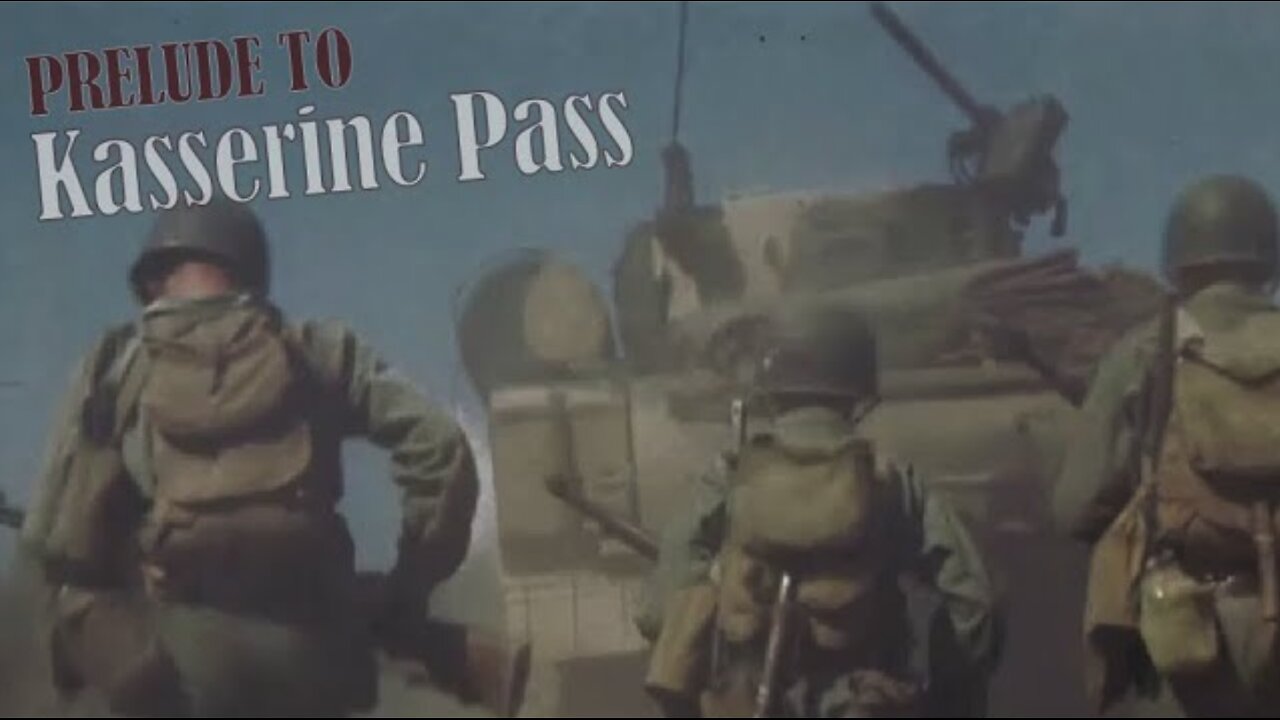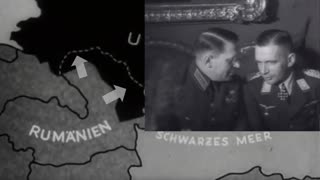Premium Only Content

Sensationally restored COLOR FOOTAGE by George Stevens, Egypt & North Africa 43 Prelude to Kasserine
🔥PREVIEW ALL YOUTUBE VIDEOS
www.Patreon.com/Military1945
Episode 229
Be sure to give this video a THUMBS UP! Best way to support the channel!
SUBSCRIBE to M1945
https://www.youtube.com/channel/UCN2UQVe6Xaqz5rLFaWq8-mw?sub_confirmation=1
ORIGINALS for sale...
https://www.militaria1945.com
The Battle of Kasserine Pass took place from 18-24 February 1943 at Kasserine Pass, a 2-mile-wide (3.2 km) gap in the Grand Dorsal chain of the Atlas Mountains in west central Tunisia. It was a part of the Tunisian campaign of World War II.
The Axis forces, led by Generalfeldmarschall Erwin Rommel, were primarily from the Afrika Korps Assault Group, the Italian Centauro Armored Division and two Panzer divisions detached from the 5th Panzer Army, while the Allied forces were from the U.S. II Corps (Major General Lloyd Fredendall), the British 6th Armoured Division (Major-General Charles Keightley) and other parts of the First Army (Lieutenant-General Kenneth Anderson).
The battle was the first major engagement between U.S. and Axis forces in Africa. The initial handful of American battalions were inexperienced and poorly led; they suffered many casualties and were successively pushed back over 50 miles (80 km) from their original positions west of Faïd Pass, until they met an advancing brigade of the U.S. 1st Armored Division. British forces were also driven back, losing all eleven of their tanks in the process. After the initial defeat, Allied reinforcements with strong artillery support stopped the Axis advance, and recaptured the mountain passes in western Tunisia, defeating the Axis offensive. The Axis force was overextended and pinned down by the Allied artillery. Facing counterattacks and airstrikes, they withdrew from the Kasserine Pass by 24 February.
Anderson was subsequently criticised by his contemporaries for, among other things, dispersing the three combat commands of the 1st Armored Division, despite the objections of the divisional commander, Major-General Orlando Ward. As a result of lessons learned in this battle, the U.S. Army instituted sweeping changes in unit organization and tactics, and replaced some commanders and some types of equipment.
Background
U.S. and British forces landed at several points along the coast of French Morocco and Algeria on November 8, 1942, during Operation Torch. This came only days after the breakthrough of the British Eighth Army (Lieutenant-General Bernard Montgomery) following the Second Battle of El Alamein. In response, German and Italian troops were ferried in from Sicily to occupy Tunisia, one of the few easily defended areas of North Africa and only one night's sail from bases in Sicily. This short passage made it very difficult for Allied naval vessels to intercept Axis transports, and air interdiction proved equally difficult, because the nearest Allied airbase to Tunisia, at Malta, was over 200 mi (320 km) away.
The Run for Tunis in November and December 1942 is the term for an attempt to reach Tunis before German and Italian reinforcements could arrive. Because of the poor road and rail communications, only a small, division-sized Allied force could be supplied and due to the excellent defensive terrain, small numbers of German and Italian troops were sufficient to defeat the attempt. The Allied build-up continued, more aircraft became available and new airfields in eastern Algeria and Tunisia were built. The Allies reduced the flow of Axis troops and equipment into Tunis and Bizerta, but a sizable Axis force was already ashore.
On January 23, 1943, the Allied Eighth Army took Tripoli, Erwin Rommel's main supply base. Rommel had anticipated this, switching his line of supply to Tunis with the goal of blocking the southern approach to Tunisia from Tripoli at Gabès. The Mareth Line, which the French had built to protect against an Italian attack from Libya, was
... a line of antiquated French blockhouses, which in no way measured up to the standards required by modern warfare....
— Rommel
Allied troops had already crossed the Atlas Mountains and set up a forward base at Faïd, in the foothills on the eastern arm of the mountains, an excellent position to thrust east to the coast, split the Axis forces in southern Tunisia from the forces further north, and cut the line of supply to Tunis.
-
 9:16
9:16
Military1945
7 months agoRomanian 4th Army Odessa - Ion Antonescu - Bessarabia and Northern Bukovina - Molotov-Ribbentrop
2591 -
 1:18:23
1:18:23
Simply Bitcoin
2 days ago $0.85 earnedThe Bitcoin Crucible w/ Alex Stanczyk and Lawrence Lepard
2.81K3 -
 1:25:03
1:25:03
Jeff Ahern
3 hours ago $7.85 earnedThe Saturday Show with Jeff Ahern
56.3K8 -
 1:31:56
1:31:56
Michael Franzese
18 hours agoWill NBA do anything about their Gambling Problems?
113K22 -
 57:26
57:26
X22 Report
7 hours agoMr & Mrs X - The Food Industry Is Trying To Pull A Fast One On RFK Jr (MAHA), This Will Fail - EP 14
85.2K51 -
 2:01:08
2:01:08
LFA TV
1 day agoTHE RUMBLE RUNDOWN LIVE @9AM EST
142K11 -
 1:28:14
1:28:14
On Call with Dr. Mary Talley Bowden
5 hours agoI came for my wife.
21.3K23 -
 1:06:36
1:06:36
Wendy Bell Radio
10 hours agoPet Talk With The Pet Doc
59.6K28 -
 30:58
30:58
SouthernbelleReacts
2 days ago $7.50 earnedWe Didn’t Expect That Ending… ‘Welcome to Derry’ S1 E1 Reaction
38.7K10 -
 13:51
13:51
True Crime | Unsolved Cases | Mysterious Stories
5 days ago $17.84 earned7 Real Life Heroes Caught on Camera (Remastered Audio)
56.6K11